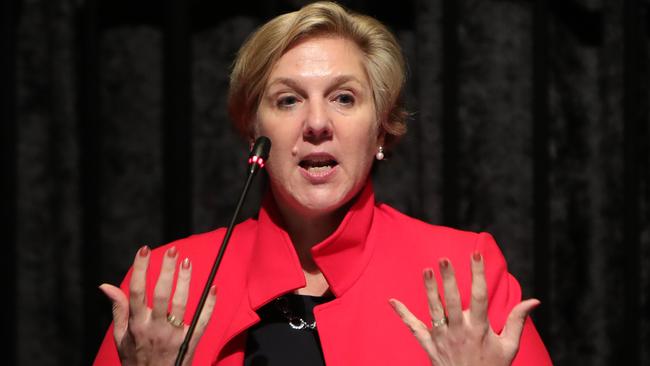Tesla chair Robyn Denholm urges innovation in Australian minerals industry
Australia needs huge investment to make the best of its advantages in battery and green energy technology, says Tesla’s chair.

Australia needs massive investment and innovation in its manufacturing and mineral refining sector to take best advantage of the boom in battery and green energy technology or risks losing the benefits of its mineral wealth to competitors, according to Tesla chair Robyn Denholm.
Speaking at a Minerals Council of Australia event in Canberra on Wednesday, Ms Denholm said Tesla expected to buy more than $1 billion a year worth of lithium, nickel and other minerals from Australian mines over the next few years, but Australian miners and manufacturers should be capturing a far greater share of the wealth generated by its natural resources.
“We can achieve a thriving economy fuelled by better jobs, mining jobs, advanced manufacturing jobs, technology jobs, renewable energy jobs, and a thriving environment enabled through cleaner energy and practices,” she said.
“By 2030, the value of the global lithium ion battery market is forecast to be $400 billion. That’s eight times the revenue generated by Australia’s coal exports in 2020. The opportunity for Australia is extraordinary and now is the time to seize it.”
Ms Denholm said three-quarters of the lithium Tesla used in its batteries is sourced from Australia, along with about a third of its nickel, partly because of the Australian mining industry’s reputation for high environmental, social and governance standards.
“Australian mining companies do have a good reputation, you have great expertise and professionalism and are preferred by many manufacturers who are increasingly concerned about meeting both today’s and future ESG requirements,” she said.
“A values-led mining industry has greater value to Tesla and to an increasing portion of the global marketplace.
“Can Australia move even further up the value chain? To large-scale cell manufacturing? To vehicles? In my view, that’s a possibility. Australia has the minerals, the know-how and many of the skills.”
Taking advantage of the opportunity would require Australia to catch up to the decades of investment in chemicals and manufacturing capacity made by other nations, she said, with a limited window for the nation to become a clean energy powerhouse.
And doing so would require leadership from governments, and significant investment from miners and manufacturers.
“Every industrial revolution in this country has been assisted by government leadership working with industry. From building our roads and rail, to laying down power lines from home to home, and building the telecommunications networks that keep us connected to each other and the world,” she said.
“At the advent of the sustainable-energy age, we need governments at all levels to back Australian mining, back electric vehicles and back battery storage so that together we can seize this enormous economic and environmental opportunity.”
At stake was the possibility of greater local manufacturing of lithium batteries and eventually even electric vehicles.
“Imagine an Australia where lithium is mined in Ravensthorpe, it’s refined in Kwinana, used to manufacture battery cells in Rockhampton which are installed in a bus built in Moss Vale. The bus is recharged with equipment built and designed in Brisbane, powered by Australian solar energy courtesy of silicon quartz mined in South Australia.
“It’s actually not that hard to imagine because most of those things are already happening or are about to happen.”





To join the conversation, please log in. Don't have an account? Register
Join the conversation, you are commenting as Logout